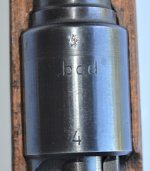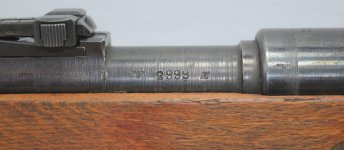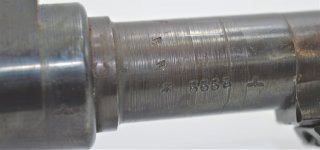Just got this in the mail this week. It came in surprisingly fast. Beautiful condition throughout. Made up of mostly armourer parts. Pretty crude. The shank of the barrel was obliterated by a machine. You can see the poor machining, looks like it slipped during installation as well. I can see the ghost of a straight script e after the script ce, wonder if this is part of a previous barrel code, or the lot info which is missing......only data ce e/37 e/37 Also the receiver has a e/1 in an odd location. This is an oddity I was happy to add to my collection as even though it is December 44 or early 45 assembled, and utilizes a kriegsmodell trigger guard, it is fully numbered like a mid or early 44 rifle. Also has a couple salvaged imperial parts.
ce44 X block using armourer bcd receiver.
Sight hood - blued
Front sight base - blued
Front band- blued, speed milled, serialized 2999
Rear band- stamped, blued, serialized on bottom 29 99
Band Spring- blued, stamped
Bayo lug- blued, salvaged Imperial part. Sn and imperial acceptance
Hand guard- RGL, serialized 2999
Sight leaf- blued, serialized 2999, i, e/1
Sight slide - blued, serialized 2999, i, e/1
Sight lock - blued, serialized 2999, i
Rear sight base- blued, i, e/1
Ramp- blued, serialized 2999, i, e/1
Barrel- blued, proofed, serialized 2999,
Barrel Code: ce e/37 e/37
Receiver- blued, bcd4 coded, l, e/1, e/37 on right side. E/37 top final, Sauer style proof on left side. e/1 below wood, right side near screw ferrule
Trigger guard- blued, byf e/135, no locking screw provision
Floor plate - blued, milled, serialized 2999, l marked
Follower- blued, lxr
Bolt- blued, l, proofed on rear flat, serialized 2999
Safety - blued, e marked, serialized 2999
Bolt Sleeve- blued, serialized 2999, ghn marked
Cocking Piece- blued, serialized 2999, e marked
Firing pin- white. serialized 2999, e marked
Extractor- blued, plum, l
Ejector box- blued,
Ejector screw- blued
Front action screw- blued, notched
Rear action screw - blued, notched
Trigger- blued, e marked
Sear- white, e marked
Stock - RGL, e/H, waa37 on wrist, 2999 in channel. 4-12-44 stock date and BH maker code.
Recoil Lug - salvaged Imperial part
Butt plate - blank, cupped















ce44 X block using armourer bcd receiver.
Sight hood - blued
Front sight base - blued
Front band- blued, speed milled, serialized 2999
Rear band- stamped, blued, serialized on bottom 29 99
Band Spring- blued, stamped
Bayo lug- blued, salvaged Imperial part. Sn and imperial acceptance
Hand guard- RGL, serialized 2999
Sight leaf- blued, serialized 2999, i, e/1
Sight slide - blued, serialized 2999, i, e/1
Sight lock - blued, serialized 2999, i
Rear sight base- blued, i, e/1
Ramp- blued, serialized 2999, i, e/1
Barrel- blued, proofed, serialized 2999,
Barrel Code: ce e/37 e/37
Receiver- blued, bcd4 coded, l, e/1, e/37 on right side. E/37 top final, Sauer style proof on left side. e/1 below wood, right side near screw ferrule
Trigger guard- blued, byf e/135, no locking screw provision
Floor plate - blued, milled, serialized 2999, l marked
Follower- blued, lxr
Bolt- blued, l, proofed on rear flat, serialized 2999
Safety - blued, e marked, serialized 2999
Bolt Sleeve- blued, serialized 2999, ghn marked
Cocking Piece- blued, serialized 2999, e marked
Firing pin- white. serialized 2999, e marked
Extractor- blued, plum, l
Ejector box- blued,
Ejector screw- blued
Front action screw- blued, notched
Rear action screw - blued, notched
Trigger- blued, e marked
Sear- white, e marked
Stock - RGL, e/H, waa37 on wrist, 2999 in channel. 4-12-44 stock date and BH maker code.
Recoil Lug - salvaged Imperial part
Butt plate - blank, cupped




















